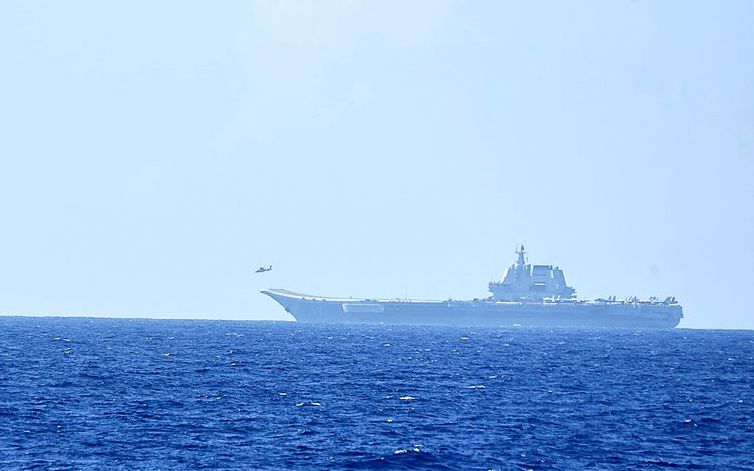
The People’s Liberation Army Navy carrier CNS Shandong (17) on Thursday deployed into the western Pacific for the third time this year while, on the same day, the U.S. accused China of conducting an unsafe intercept and released a video of the incident. China has also claimed a U.S. destroyer acted unprofessionally during an encounter around the Paracel Islands in August.
On Thursday, Taiwan’s Ministry of National Defense issued a brief release along with a photograph, stating that the Shandong carrier formation had passed through the Bashi Channel and entered the western Pacific, and that its military was monitoring the PLAN carrier. The release did not identify which PLAN ships were with Shandong. This is Shandong’s third deployment to the western Pacific. Its initial deployment in April saw it operate 19 days in the Philippine Sea, followed by a five-day deployment the Philippine Sea followed.
Japan so far has not issued any releases on Shandong’s movements, though Japan normally despatches ships to shadow PLAN carriers operating near its waters, as was the case for the previous deployment. The Joint Staff Office (JSO) of Japan’s Ministry of Defense issued a release on Thursday stating that from the morning and afternoon of that day a presumed Chinese unmanned air vehicle (UAV) flew in from the East China Sea and passed through the airspace between Yonaguni Island and Taiwan to enter the Philippine Sea. It then circled in an area southwest of the Sakishima Islands before leaving through the Bashi Channel. The release stated that fighters of the Japan Air Self Defense Force (JASDF) Southwest Air Command were scrambled in response.
On Friday, the JSO issued a release stating that on that morning, a Chinese Y-9 electronic intelligence gathering aircraft flew in from the East China Sea and transited through the Miyako Strait to reach the Philippine Sea. The aircraft subsequently flew back through the Miyako Strait to return to the East China Sea. JASDF Southwest Air Command fighters were scrambled in response, JSO stated.
Meanwhile, carrier USS Ronald Reagan (CVN-76) is in the South China Sea as of Thursday based on images released by the Pentagon. The day before, it was in the Philippine Sea hosting Filipino media. The Ronald Reagan Carrier Strike Group consists of carrier Ronald Reagan, cruisers USS Antietam (CG-54) and USS Robert Smalls (CG-62) and destroyer USS Shoup (DDG- 86). On Thursday, Shoup conducted at-sea replenishment with fleet oiler USNS Yukon (T-AO-202) in the South China Sea.

On Thursday, U.S Indo-Pacific Command (INDOPACOM) issued a release stating that on Wednesday, a Chinese J-11 fighter pilot executed an unsafe intercept of a U.S. Air Force B-52 bomber in international airspace above the South China Sea. “During the nighttime intercept, the PRC pilot flew in an unsafe and unprofessional manner, demonstrated poor airmanship by closing with uncontrolled excessive speed, flying below, in front of, and within 10 feet of the B-52, putting both aircraft in danger of collision. We are concerned this pilot was unaware of how close he came to causing a collision,” read the release, which also included a video of the incident.
The release went on to state that the incident was the latest example of what the Department of Defense described in the 2023 China Military Power Report (CMPR) as “unsafe, unprofessional, and other behaviors that seek to impinge upon the ability of the United States and other nations to safely conduct operations where international law allows.” The CMPR included more than 180 such interactions since the fall of 2021. The Pentagon had released declassified images and videos showing dangerous and risky flying by PRC aircraft conducting intercepts.
While fighter intercepts are routine internationally, China’s intercepts often are contentious, not only because of its history of dangerous flying, but also because the intercepts take place in international waters and airspace that China claims as its sovereign territory. These include its artificial islands in the South China Sea, as witnessed by USNI, and also on territories held by other nations but claimed by China, such as the intercept of a Royal Canadian Air Force CP-140 Aurora maritime surveillance aircraft over Japan’s Senkaku islands.
China. meanwhile, is claiming that the United States is the side that has been making provocations. In the China Ministry of National Defense monthly press conference on Thursday, spokesperson Senior Colonel Wu Qian released a video of an encounter between U.S. destroyer USS Ralph Johnson (DDG-114) and PLAN destroyer CNS Guilin (164) and frigate CNS Huangshan (570) on Aug. 19 in the vicinity of the Paracel Islands in the South China Sea.
The video footage’s opening statement claims Ralph Johnson conducted close-in harassment of the PLAN ships and carried out provocative actions such as making a sharp turn, sudden acceleration and deceleration, purposely crossing the bow of Guilin and approached as close as 670 meters to the PLAN ships. It stated that the U.S. actions violated the International Regulations for Preventing Collisions at Sea, the Code for Unplanned Encounters at Sea and the Rules for Behaviour for Safety of Air and Maritime Encounters agreement between China and the U.S. and endangered the safety of personnel and ships of both sides.
Wu went on to say that the video proves the U.S. is the side making provocations, taking risks and “muddling the water.” Wu stated that the Chinese military has more video evidence but he would not show them that day because of time constraints. “It was the US side that came to China’s doorstep to provoke and stir up troubles,” said Wu. “The Chinese military is always on high alert and will take all necessary measures to resolutely defend China’s national sovereignty, security, and maritime rights and interests.”





